Princess Henrietta of Nassau-Weilburg
Henrietta Alexandrine Friederike Wilhelmine of Nassau-Weilburg, then of Nassau (areas now part of Germany) (30 October 1797 Palace Eremitage, Bayreuth – 29 December 1829, Vienna) was the wife of Archduke Charles, Duke of Teschen. Her husband was a notable general of the Napoleonic Wars and victor of the Battle of Aspern-Essling against Napoleon I of France.
| Princess Henrietta | |||||
|---|---|---|---|---|---|
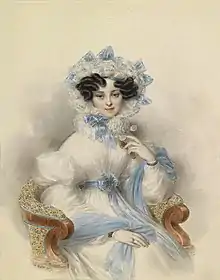 | |||||
| Duchess of Teschen | |||||
| Tenure | 10 February 1822 – 29 December 1829 | ||||
| Born | 30 October 1797 Palace Eremitage, Bayreuth, Kingdom of Prussia | ||||
| Died | 29 December 1829 (aged 32) Vienna, Austrian Empire | ||||
| Burial | |||||
| Spouse | Archduke Charles, Duke of Teschen | ||||
| Issue Details... | Maria Theresa, Queen of the Two Sicilies Archduke Albrecht, Duke of Teschen Archduke Karl Ferdinand Archduke Friedrich Ferdinand Archduke Rudolph Archduchess Maria Karoline Archduke Wilhelm Franz | ||||
| |||||
| House | Nassau-Weilburg | ||||
| Father | Frederick William, Prince of Nassau-Weilburg | ||||
| Mother | Burgravine Louise Isabelle of Kirchberg | ||||
| Religion | Calvinism | ||||
Family
Henrietta was the youngest daughter of Frederick William of Nassau-Weilburg (1768–1816) and his wife Burgravine Louise Isabelle of Kirchberg. Her paternal grandparents were Karl Christian of Nassau-Weilburg and Princess Wilhelmine Carolina of Orange-Nassau.
Wilhelmine Carolina was a daughter of William IV, Prince of Orange and Anne, Princess Royal. Anne was in turn the eldest daughter of George II of Great Britain and Caroline of Ansbach.
Marriage
.jpg.webp)
On 15 September/17 September 1815 in Weilburg, Henrietta married Archduke Charles of Austria. The bride was almost eighteen years old and the groom forty-four. Her husband was a son of Leopold II, Holy Roman Emperor and Maria Louisa of Spain. However he had been adopted and raised by his childless aunt Marie Christine of Austria and her husband Albert of Saxe-Teschen. He was the heir to the Duchy of Teschen and would succeed in 1822. This marriage was a very happy one.
She has been known as the person who popularized the Christmas tree in Vienna after it was already introduced by Fanny von Arnstein in 1814 during the Vienna Congress.[1]
Henrietta died young of scarlet fever, which she had caught while nursing her children through the same illness. She is the only Protestant buried in the Imperial Crypt in the Capuchin Church. This was allowed by order of her brother-in-law Emperor Francis I, who said, "She dwelt among us when she was alive, and so she shall in death".
Henrietta and Charles had seven children.
Issue
| Issue | |||
|---|---|---|---|
| Name | Portrait | Lifespan | Notes |
| Archduchess Maria Theresa Queen of the Two Sicilies. |
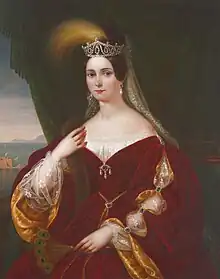 |
1816– 1867 |
Married Ferdinand II of the Two Sicilies, had issue |
| Archduke Albrecht Duke of Teschen |
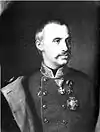 |
1817– 1895 |
Married Princess Hildegard of Bavaria, had issue |
| Archduke Karl Ferdinand |
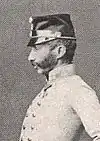 |
1818– 1874 |
Married Archduchess Elisabeth Franziska of Austria, had issue |
| Archduke Friedrich Ferdinand Commander-in-Chief of the Austrian Navy |
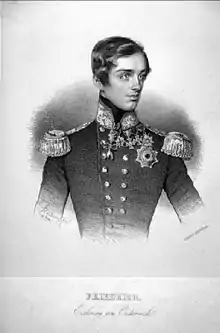 |
1821– 1847 |
Died unmarried |
| Archduke Rudolph |
1822– 1822 |
Died in childhood | |
| Archduchess Maria Karoline |
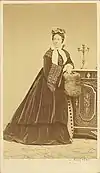 |
1825– 1915 |
Married her first cousin Archduke Rainer of Austria, no issue |
| Archduke Wilhelm Franz Grand Master of the Teutonic Knights |
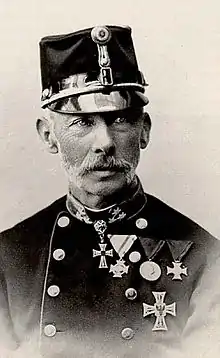 |
1827– 1894 |
Died unmarried |
Ancestry
| Ancestors of Princess Henrietta of Nassau-Weilburg | |||||||||||||||||||||||||||||||||||||||||||||||||||||||||||||||||||||||||||||||||||||||||||||||||||||||||||||||||||||||||||||||||||||||||||||||||||||||||||||||||||||||||||||||||||||||||||||||||||||||||||||||||||||||||||||||||||||||||||||||||||||||||||||||||||||||||||||||||||||||||
|---|---|---|---|---|---|---|---|---|---|---|---|---|---|---|---|---|---|---|---|---|---|---|---|---|---|---|---|---|---|---|---|---|---|---|---|---|---|---|---|---|---|---|---|---|---|---|---|---|---|---|---|---|---|---|---|---|---|---|---|---|---|---|---|---|---|---|---|---|---|---|---|---|---|---|---|---|---|---|---|---|---|---|---|---|---|---|---|---|---|---|---|---|---|---|---|---|---|---|---|---|---|---|---|---|---|---|---|---|---|---|---|---|---|---|---|---|---|---|---|---|---|---|---|---|---|---|---|---|---|---|---|---|---|---|---|---|---|---|---|---|---|---|---|---|---|---|---|---|---|---|---|---|---|---|---|---|---|---|---|---|---|---|---|---|---|---|---|---|---|---|---|---|---|---|---|---|---|---|---|---|---|---|---|---|---|---|---|---|---|---|---|---|---|---|---|---|---|---|---|---|---|---|---|---|---|---|---|---|---|---|---|---|---|---|---|---|---|---|---|---|---|---|---|---|---|---|---|---|---|---|---|---|---|---|---|---|---|---|---|---|---|---|---|---|---|---|---|---|---|---|---|---|---|---|---|---|---|---|---|---|---|---|---|---|---|---|---|---|---|---|---|---|---|---|---|---|---|---|---|---|---|
| |||||||||||||||||||||||||||||||||||||||||||||||||||||||||||||||||||||||||||||||||||||||||||||||||||||||||||||||||||||||||||||||||||||||||||||||||||||||||||||||||||||||||||||||||||||||||||||||||||||||||||||||||||||||||||||||||||||||||||||||||||||||||||||||||||||||||||||||||||||||||
References
- "News Detail". Jüdisches Museum Wien (in German). Retrieved 2021-09-20.
External links
- Marek, Miroslav. "A listing of descendants of the House of Nassau-Weilburg". Genealogy.EU.